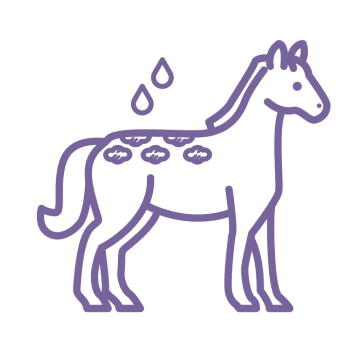What is Rain Rot?
If your horse’s coat is matted into tufts or irregular patterns, and if they have developed tight scabs that come off with clumps of hair attached, leaving raw, inflamed spots on the skin, they most likely have a case of rain rot or rain scald. Rain rot is neither life threatening nor career ending, but it is painful for your horse and can cause long term damage to their skin and coat.
Technically known as dermatophilosis, rain rot is the most common skin disease in horses, and is caused by a bacterium called Dermatophilus congolensis, which lies dormant in horse skin. This bacterium, combined with moisture and warmth on the horse’s coat create an environment in which rain rot can thrive. When the horse’s skin becomes compromised by humidity, high temperatures, wetness, or biting insects, the bacterium produces hyphae (threadlike tentacles) that penetrate the skin and spread in all directions. The result is an acute inflammatory skin response.
Both internal and external conditions enable the bacterium to multiply. In fact, a weak immune system, a damaged skin barrier, poor nutrition, poor hygiene, and other stressful circumstances can heighten the risk of horses contracting the disease. You’ll typically spot rain rot along the horse’s dorsal surfaces, usually beginning at the croup, and spreading to the neck, back, and hindquarters. Often mistaken for a fungal disease, the condition can be characterized by the development of crusty scabs that peel off, removing clumps of hair with them, and result in infected, bare patches on the horse’s skin.
When and Where Does Rain Rot Occur?
Rain rot is most prevalent in areas of high humidity, warm temperatures, and heavy rainfall. Spring and summer seasons provide a fertile environment for bacteria to thrive, however it can also develop in winter under a warm blanket.
How Do I Prevent Rain Rot?
Preventing rain rot is often a matter of good grooming. A dirty coat naturally contains more organisms and skin debris to feed them. Frequent brushing or vacuuming limit the incidence and severity of rain rot. Some horses, however, are particularly susceptible and may need to be protected from wet weather to prevent future outbreaks. Avoid sharing brushes, tack, blankets, or other equipment belonging to afflicted horses, as this will help prevent the spreading of rain rot.
The sooner you can detect rain rot, the sooner you can spare your horse extended discomfort and extended damage to the hair follicle. Once you suspect rain rot, begin
treatment immediately.
How is Rain Rot Treated?
Day 1 – To treat rain rot on your horse, apply
Equiderma Skin Lotion liberally. Resist the urge to pick the scabs, as they are very painful and can bleed. Equiderma Skin Lotion assists you in debriding these scabs easily and painlessly. Just apply and leave on.
Day 2 – Gently shampoo the area with
Equiderma Neem Shampoo and rinse well. Scabs will come off easily and rinse away. You'll notice an improvement in skin health from the first treatment. Reapply Equiderma Skin Lotion and leave on.
Day 3 – Reapply Equiderma Skin Lotion and leave on. At this point, treatment is complete. You will likely notice hair regrowth and a cessation of infection and inflammation.
How Long Does It Take For Rain Rot To Heal?
As mentioned, the earlier you can detect rain rot, the easier it will be to treat and the more quickly you will see it resolved. It is imperative that you begin treatment as quickly as possible. Leaving it to heal on its own will cause more damage than if the condition was treated right away. With treatment, rain rot usually takes one to four weeks depending on the severity of the case. The more quickly you can treat it, the sooner it can begin healing, which will minimize the damage and the severity of the condition.
For the very best rain rot treatment and prevention, and for all other skin solutions for your horse, shop
Equiderma's horse care products! And for helpful videos and info, check out our Youtube page
here.

